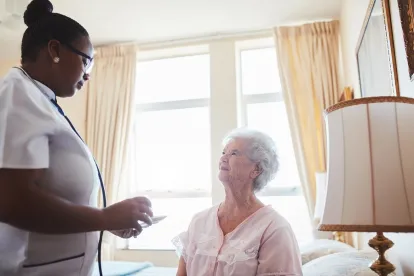Late last month, the Biden Administration announced the second installment of its recovery plan, dubbed the “American Jobs Plan” (the “Plan”). The Plan’s $2.3 trillion price tag includes $400 billion to revamp and reinvest in Medicaid’s home and community-based services (“HCBS”) over the next eight (8) years – representing over 17% of the Plan’s budget.
Biden’s HCBS strategy aims to provide more solutions to help the overburdened healthcare system serve America’s aging and other special-needs populations through increased funding for Medicaid HCBS.
The Plan Aims to Support Independent Living and Foster the “Care Infrastructure.”
Medicaid is the federal-state health program for 72 million children and adults in low-income households. Currently, Medicaid offers two types of long-term care: HCBS and institutional care (e.g., nursing homes). However, states have discretion as to whether to offer HCBS in addition to institutional care, which has led to significant gaps in services across state lines and excess demand. Across 41 states, nearly 820,000 people are on waiting lists for Medicaid HCBS with an average wait of 39 months.[1] Though 57% of Medicaid’s long-term care budget goes to HCBS, half of states still spend twice as much on institutional care as they do on HCBS.[2]
HCBS allow aging and other special-needs populations to live independently. Services are broad and often include visits from healthcare providers, assistance with daily tasks, case management, etc. The need and demand for this genre of care is expected to explode as America’s aging population expands to 74 million in 2030.
Expanding access to HCBS will help alleviate the 53 million family members providing care to vulnerable seniors and people with disabilities. This care often takes a significant emotional and financial toll on the caregivers—including, on average, 24 hours of additional work per week and $7,000 in out-of-pocket costs.[3]
Beyond a simple check to support the delivery of HCBS, the Plan aims to bolster what the Administration calls the “care infrastructure” – i.e., the more than 790,000 workers providing HCBS who are often women, immigrants and people of color. On average, these workers earn only $12 an hour, and nearly one-third do not receive employer-backed health insurance.[4] Without intervention, these low wages will make it difficult to recruit more caregivers as demand for HCBS increases. The Plan promises to increase pay and benefits for the workers providing these valued services. Further, Biden hopes to reauthorize a Medicaid program that helps transition people out of nursing homes and back into their communities.
The Administration’s effort aligns with many Americans’ belief that aging adults should be able to remain in their homes. The Administration also contends that doing so is less expensive than nursing-home care.
Congress Needs to Fill in the Details.
Thus far, the Plan lacks specific provisions and has yet to be memorialized in a bill. Moreover, the Plan will likely face a lengthy political battle, which will surely highlight the atypically quick passage of the American Rescue Plan, which included $12.7 billion for HCBS through Medicaid.
Despite a dearth of detail, the skeleton of the Plan reveals its greatest limitation: Medicaid’s strict eligibility guidelines. Americans often will not qualify unless they have only $2,000 or less in total assets, limiting the program’s ability to help lower-to-upper middle class individuals and families.
The Plan Has Been Met With Industry Praise.
Nonetheless, industry response has been largely positive. The American Association of Family Physicians commended the Plan for its “critical investments necessary to further strengthen our nation’s health care system and address underlying social determinants of health that contribute to health inequities.” Moreover, the President of the National Association for Home Care & Hospice, William A. Dombi, praised the Plan as a “monumental advance” in the “effort to provide full access to health care outside of an institution.” While the response was generally positive, the American Health Care Association and National Center for Assisted Living (AHCA/NCAL), which represents nursing homes, argued that institutions also need financial help in order to serve the rapidly aging population. Though AHCA/NCAL applauded investments in HCBS, it emphasized that the average age of a nursing home resident is 85, and most have multiple underlying health conditions that require a high level of specialized care that in-home care is often unable to provide.
[1] “Medicaid Home and Community-Based Services Enrollment and Spending,” by Molly O’Malley Watts, MaryBeth Musumeci, and Priya Chidambaram, Kaiser Family Foundation (February 2020).
[2] Id.
[3] “Family Caregiving Costs Study,” by Chuck Rainville, Laura Skufca, and Laura Mehegan, American Association of Retired Persons (November 2016).
[4] “U.S. Home Care Workers: Key Facts” PHI (2019).





 />i
/>i

